The Chianti Region
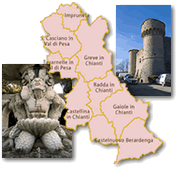
Travelling the roads of the Chianti region means discovering one of the world’s most famous winegrowing districts. Land of castles and ancient abbeys, the Chianti region is also the land of an ancient farming tradition that developed from winegrowing, which sinks its roots into antiquity. In the shade of noble villas and manor-houses, which are also important examples of military architecture, grow precious gardens, abounding in rare and exotic plants.
A visit to the Chianti region can not but start from an age-old farm like Montevertine near Radda in Chianti. It hosts a small museum illustrating the farming production of the territory.
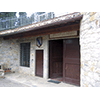
This little Museum was founded in 1979 at the initiative of Sergio Manetti, owner of the agricultural estate of Monte Vertine and former metallurgical industrialist. It contains objects from domestic life and agricultural and craftsmen's production in the rural world of Chianti, organised according to their usage. Among the objects displayed, the visitor's attention is drawn to the trunk of a grapevine that grew over 400 years ago. The display, of the collecters' type, aims to give an idea of peasant life prior to the exodus from the countryside.
(Antonella Gozzoli)
Travelling SS429/SR429 towards Cavriglia, we reach the old Badia di Coltibuono which, as of the 11th century, was a propulsive centre of the territory’s agricultural rebirth.
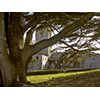
Founded in 1051 and placed under the protection of Lorenzo de’ Medici in the 15th century, it remained property of the Vallombrosan Benedictine monks until 1810 when it was transformed into a villa-farm, though preserving its original function of farming facility.
The garden revisits the layout of the old hortus conclusus: the geometrically arranged beds have box hedges, aromatic and officinal plants. In the middle of the garden there is a rectangular-shaped pool in pietra serena. The vast white fir woods surrounding the abbey are the fruit of reforestation by the monks which continued even in the 19th century. Next to the Abbey stands a cedar of Lebanon of impressive dimensions (20 metres in height, and a trunk circumference of about 7 metres in diameter), which appears on the list of monumental plants of the Region of Tuscany. Many more monumental plants of considerable botanical value can be found in the surrounding area.
(Graziano Magrini)
Taking SP408 towards Gaiole in Chianti, once past the town, you reach the very well preserved Meleto Castle. For a long time a border fortress of the Florentine territory, the manor-house constitutes a splendid example of fifteenth-century military architecture.
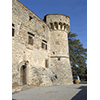
Despite its remodelling in the course of the 18th century on the occasion of its transformation into a villa, the Meleto Castle still betrays its military vocation in its irregular four-sided plan with the keep tower in the middle. Originally (11th century) in the possession of the Vallombrosan monks of the nearby Abbey di Coltibuono, the castle was at length contended by the provinces of Siena and Florence, for its position of control over the road connecting the Upper Valdarno and the Chianti territory. It remained at length a stronghold of the Florentines who, in 1480, reinforced its defensive structures. In particular, two powerful cylindrical keeps built at that time, present the typical characteristics of contemporary military constructions: a high scarp, a vertical segment marked by projecting double cordons in stone, the defensive system projecting on triangular stone corbels and little brick arches, and the insertion of embrasures for both archery and cannons, today in part lost. Never destroyed, but partially dismantled to transform it into a villa in the first half of the 18th century, it still conserves the furnishings of the period, including a little theatre of 1742 equipped with seven original sceneries. Property of the Ricasoli family until 1968, it is today the headquarters of a prestigious winegrowing firm.
(Elena Fani)
A short distance away, taking first SP408 and then turning off onto SS484 and proceeding towards Castelnuovo Berardenga, the scenographic Brolio Castle is worth a stop. Despite its neo-gothic restructuring, its nucleus is medieval.
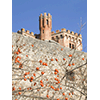
Property of the Ricasoli family, Brolio Castle dates back to the upper Middle Ages, and owes its name to the Lombard term brolo (enclosed green space). In the second half of the 15th century, the castle was transformed on a project by Giuliano da Sangallo into a powerful construction with an irregular polygonal plan, five bastions and a lookout tower. Once it lost its military function, it was transformed into a genteel residence. In 1835, by order of baron Bettino Ricasoli, a building designed by architect Pietro Marchetti was erected in the fortified complex.
The disposition of green areas by botanist Simone Ricasoli consists of two areas dating to different periods. The sixteenth-century Italian garden is characterised by little lanes and box hedges, while the nineteenth-century romantic park around the castle has various botanical species from many parts of the world, and planted by Ricasoli himself. Also particularly interesting are several specimens of monumental fir tree which today have reached a height of 30-40 metres.
(Graziano Magrini)
The nearby Villa Chigi Saracini at Castelnuovo Berardenga can be the end of the itinerary. Its vast park is a splendid example of a romantic garden where sculptures, pavilions and fountains fit into a wisely planned natural backdrop.
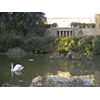
Count Galgano Saracini ordered the construction of the villa and park, which can be set between 1820 circa and 1840, and is in part attributed to architect Agostino Fantastici.
Traversed by numerous lanes and paths, the park has a great variety of tree species and high-trunk trees, such as Atlantic cedars and holm-oaks and, by means of a Doric tepidarium of neoclassical inspiration, is connected to the "Italian" garden in front of the villa. In addition to the original layout of the park and garden, Fantastici also built the aforementioned tepidarium, the lake, tufa grotto and the carriageable bridge with three arches that connects the villa to the hill of San Quirico. The fountain was instead created by Tito Sarrocchi in 1866.
The present look of the park is due to the efforts of count Guido Chigi Saracini, founder of the Accademia Musicale Chigiana of Siena, still active today, which hosted numerous internationally famous artists and organises musical events and other cultural initiatives. He commissioned sculptor Vico Consorti (1902-1979) from Siena to create a series of statues dedicated to great musicians to position in the park, in the intent to make it a sort of "ideal gallery" of music.
(Antonella Gozzoli)
****************************
Texts by Elena Fani
English translation by Victor Beard
Last update 09/gen/2008



 = libraries and archives
= libraries and archives  = scientific research centers
= scientific research centers  = memorial places of scientists
= memorial places of scientists = public health places
= public health places = places of science and worship
= places of science and worship = places of technology
= places of technology  = museums and collections
= museums and collections  = villas and gardens of science
= villas and gardens of science


